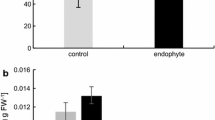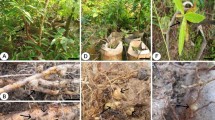Abstract
Thesium chinense (Santalaceae) is an obligate root hemiparasite and the whole weed serves as a traditional medicine in China. This paper examined chlorophyll (Chl) concentration, transpiration (E), photosynthesis (Pn), stomatal conductance (g), respiration nighttime (Rd), water use efficiency (WUE), and mineral elements of T. chinense grown with different hosts or without host. The results showed that Chl concentrations, Pn, Pnmax, and WUE of T. chinense grown with host were significantly higher, approximately 1.5–3 folds, than that grown without host. E and g value of T. chinense greatly exceeded that of their hosts during the daytime—they increased about 1.5–3.5 folds (except of Gnaphlium affine) and 1.2–3.0 folds, respectively, while maintaining little higher or equal to their host during night but very much lower than daytime. The WUE value of T. chinense was generally much less than that of their hosts, except Eremochloa ophiuroides. T. chinense grown with hosts had higher concentration of K, P, Cu and K/Ca ratio, and lower Na concentration compared with that without host plants. There were also differences among different host species backgrounds on all examined parameters of T. chinense. We pointed out that Imperata cylindrica, Prunella vulgaris, and Gnaphlium affine were more suitable hosts than E. ophiuroides. As an additional result T. chinense can mostly be independent as for C supply.






Similar content being viewed by others
References
Arnon DI (1949) Copper enzymes in isolated chloroplasts: polyphenoloxidase in Beta vulgaris. Plant Physiol 24:1–15
Cameron DD, Geniez J-M, Seel WE, Irving LJ (2008) Suppression of host photosynthesis by the parasitic plant rhinanthus minor. Ann Bot 101:573–578
Davidson NJ, True KC, Pate JS (1989) Water relations of the parasite: host relationship between the mistletoe Amyema linophyllum (Fenzl) Tieghem and Casuarina obesa Miq. Oecologia 80:321–330
Ehleringer JR, Schulze ED, Ziegler H, Lange OL, Farquhar GD, Cowan IR (1985) Xylem-tapping mistletoes: Water or nutrient parasites ? Science 227:1479–1481
Ehleringer JR, Cook CS, Tieszen LL (1986) Comparative water use and nitrogen relationships in a mistletoe and its host. Oecologia 68:279–284
Glatzel G (1983) Mineral nutrition and water relations of hemiparasitic mistletoes a question of partitioning experiments with Loranhus europaeus on Quercus peteaea and Quercus robur. Oecologia 56:193–201
Grovier RN, Nelson MD, Pate JS (1967) Hemiparasitic nutrition in angiosperms. I. The transfer of organic compounds from host to Odontites verna (Bell.) Dum. (Scrophulariaceae). New Phytol 66:285–297
Hoagland DR, Amon DI (1950) The water culture method for growing plants without soil. Circular No. 347, California Agricultural Experiment Station, University of California, Berkeley, CA. pp 1–39
Hull RJ, Leonard OA (1964) Physiological aspects of parasitism in mistletoes (Arceuthobium and Phoradendron). I. The carbohydrate nutrition of mistletoe. Plant Physiol 39:996–1007
Joshi J, Matthies D, Schmid B (2000) Root hemiparasites and plant diversity in experimental grassland communities. J Ecol 88:634–644
Klaren CH, Jansen G (1978) Physiological changes in the hemiparasite Rhinanthus serotinus before and after attachment. Plant Physiol 42:151–155
Kuo J, Pate JS, Davidson ND (1989) Ultrastructure of the haustorial interface and apoplastic continuum between host and the root hemiparasite Olax phyllanthi (Labill.) R. Br. (Olacaceae). Protoplasma 150:27–39
Lamont BB, Southall KJ (1982) Distribution of mineral nutrients between the mistletoe, Amyema preissii, and its host, Acacia acuminat. Ann Bot 49:721–725
Liu Y, Deng YL, Yu YH, Dai RJ, Xu ZH, Meng WW (2006) Determination of astragulin in Thesium Chinese by RP-HPLC. China J Chin Mater Med 31(21):1766–1767 (in Chinese with English abstract)
Lu YX, Wang JS (2004) Study on chemical constituents of Thesium chinense. Chin Tradit Herb Drugs 35(5):491–493 (in Chinese with English abstract)
Marvier MA, Smith DL (1997) Conservation implications of host use for rare parasitic plants. Conserv Biol 11:839–848
McCree KJ, Troughton JH (1966) Prediction of growth rate at different light levels from measured photosynthesis and respiration rates. Plant Physiol 41(4):559–566
Mussleman LJ (1980) The biology of Striga, Orobanche and other root-parasitic weeds. Annu Rev Phytopathol 18:463–489
Pate JS, Davidson NJ, Kuo J, Milburn JA (1990a) Water relations of the root hemiparasite Olax phyllanthi (Labill) R.Br. (Olacaceae) and its multiple hosts. Oecologia 84:186–193
Pate JS, Pate SR, Kuo J, Davidson NJ (1990b) Growth, resource allocation and haustorial biology of the root hemiparasite Olax phyllanthi (Olacaceae). Ann Bot 65:437–449
Pate JS, True KC, Rasins E (1991) Partitioning of dry matter and mineral nutrients during a reproductive cycle of the mistletoes Amyema Linophyllum (Fenzl.) Tieyhem parasitizing Cususrina obesa Miq. J Expt Bot 42:427–439
Press MC, Tuohy J, Stewart GR (1987) Gas exchange characteristics of the Sorghum–Striga host–parasite association. Plant Physiol 84:814–819
Press MC, Graves JD, Stewart GR (1988) Transpiration and carbonacquisition in root hemiparasitic angiosperms. J Expt Bot 39:1009–1014
Radomiljac AM (1998) The influence of pot host species, seedling age and supplementary nursery nutrition on Santalum album Linn. (Indian sandalwood) plantation establishment within the Ord River Irrigation Area, Western Australia. Forest Ecol Manag 102:193–201
Radomiljac AM, McComb JA, Shea SR (1998) Field establishment of Santalum album L.—the effect of the time of introduction of a pot host (Alternanthera nana R. Br.). Forest Ecol Manag 111:107–118
Radomiljac AM, McComb JA, Pate JS (1999) Gas exchange and water relations of the root hemi-parasite Santalum album L. in association with legume and non-legume hosts. Ann Bot 83:215–224
Schädler M, Roeder M, Brandl R, Matthies D (2005) Is palatability of a root-hemiparasitic plant influenced by its host species? Oecologia 146:227–233
Schulze E-D, Turner NC, Glatzel G (1984) Carbon, water and nutrient relations of two mistletoes and their hosts: a hypothesis. Plant Cell Environ 7:293–299
Shah N, Smirnoff N, Stewart GR (1987) Photosynthesis and stomatal characteristics of Striga hermonthica in relation to its parasitic habit. Plant Physiol 69:699–703
Struthers R, Lamont BB, Fox JED, Wijesuriya S, Crossland T (1986) Mineral nutrition of sandalwood (Santalum spicatum). J Expt Bot 37:1274–1284
Suetsugu K, Kawakita A, Kato M (2008) Host range and selectivity of the hemiparasitic plant Thesium chinense (Santalaceae). Ann Bot 102:49–55
Tennakoon KU, Pate JS, Stewart GR (1997) Haustorium-related uptake and metabolism of host Xylem Solutes by the Root Hemiparasitic Shrub Santalum acuminatum (R. Br.) A. DC. (Santalaceae). Ann Bot 80:257–264
Wang Z, Li SS (2006) Isolation and identification of alkaloids from Thesium chinense Turcz. Chin J Med Chem 16(5):306–309 (in Chinese with English abstract)
Acknowledgments
This research was funded by the National Science & Technology basic condition platform Projects (2005DKA21000).
Author information
Authors and Affiliations
Corresponding author
Additional information
Communicated by Z. Gombos.
Rights and permissions
About this article
Cite this article
Luo, F.L., Guo, Q.S. Influences of host species on transpiration, photosynthesis, chlorophyll and mineral contents of medicinal hemiparasite Thesium chinense Turcz. Acta Physiol Plant 32, 1093–1102 (2010). https://doi.org/10.1007/s11738-010-0501-2
Received:
Revised:
Accepted:
Published:
Issue Date:
DOI: https://doi.org/10.1007/s11738-010-0501-2




